What Happens if You Use Propane on a Natural Gas Stove?
You might have wondered, “What Happens if You Use Propane on a Natural Gas Stove?” For decades, gas stoves have been a popular choice for cooking. However, it is also important to be aware of the potential consequences of using the wrong fuel.
Read on as we will explain the advantages of using propane and provide essential steps on how to shift from natural gas to propane. Let’s dive into the details!
Table of Contents
What Set Them Apart: Propane vs Natural Gas
Below is a comparison that highlights the key differences between both gases.
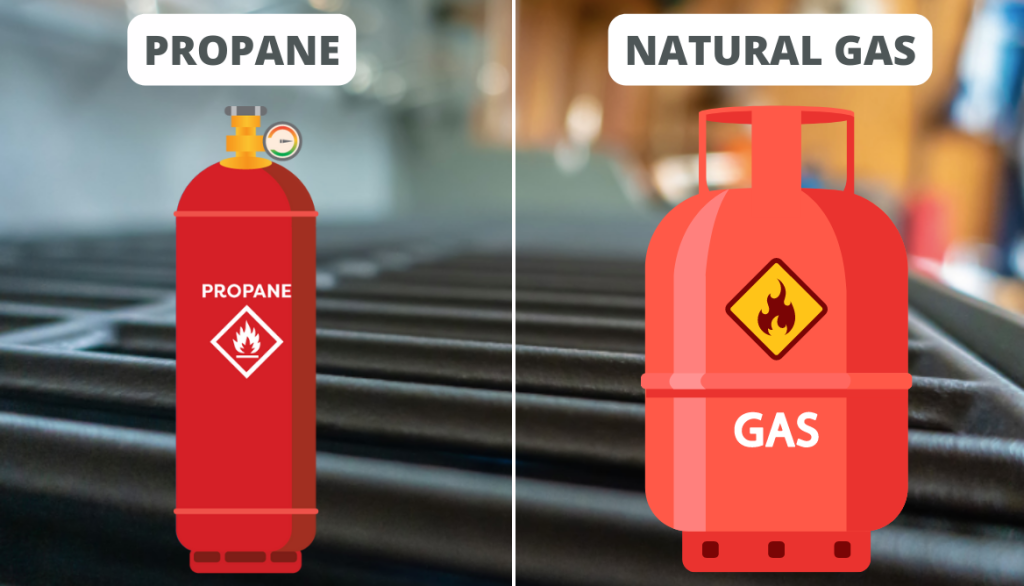
- Ignition: When it comes to ignition, natural gas is lighter and is delivered via pipelines to households and industries. Contrary, propane is a denser fuel since it has a low molecular mass. It is typically delivered in high-pressure cylinders, making it a popular choice for grills, RVs, and outdoor activities.
- Energy Content and BTU Rating: One of the most significant distinctions lies in the energy content and BTU rating. Propane has twice the energy of natural gas and has a higher BTU rating. Also, the BTU of natural gas is one unit less than propane. This makes propane an ideal candidate for heating or cooking food faster than natural gas.
- Odor: Natural gas is odorless. The mercaptan chemical is added to it for safety reasons. On the other hand, propane has a distinct odor which allows leaks to be immediately noticeable.
A Quick Sneak Peek Into Propane vs Natural Gas
Below given table comprehensively compares the differences between both gases:
Parameter | Propane | Natural Gas |
Origin: | Extracted from natural gas and crude oil | A by-product of fossil fuel with a lot of methane in it |
Density: | Heavier than air as it sinks towards low areas | Lighter than air since it rises towards high areas |
Heat output: | 3,614 degrees | 3,254 degrees |
Energy efficiency: | 2,490 BTUs per cubic foot | 1,030 BTUs per cubic foot |
Cost: | $2.86 per gallon | $1.01 per therm |
Availability: | Delivery via storage tank | Pipeline connection or utility company |
What Happens if You Use Propane on a Natural Gas Stove?
The following are a few effects of using propane on a natural gas stove:
1. Nothing Might Happen
The positive aspect of using propane is that it may not harm your natural gas stoves. Despite the distinct characteristics of natural gas and propane, they can be safely used interchangeably.
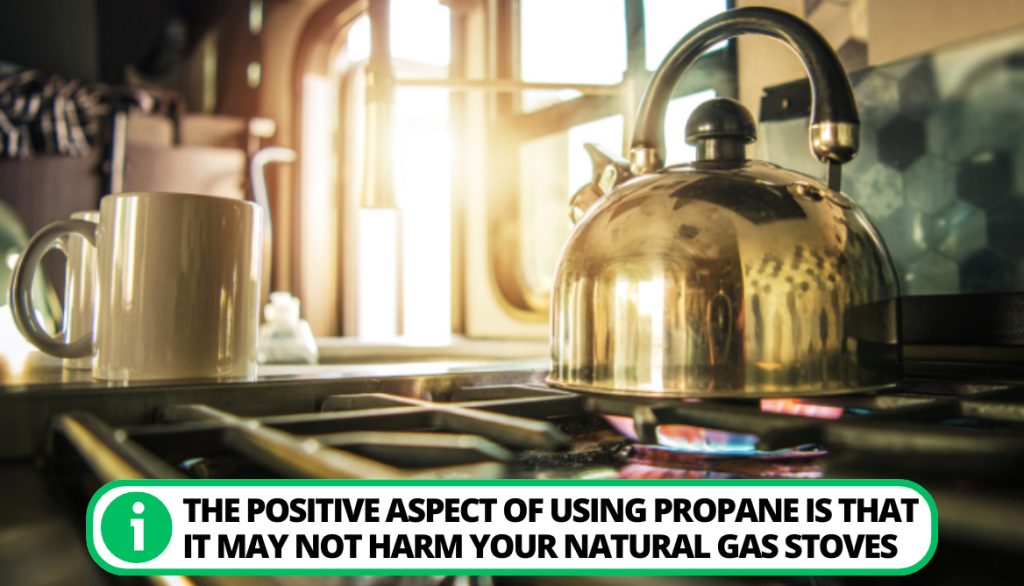
2. Fire Blowback
Using propane on a natural gas stove can pose several hazards in some scenarios, as described below:
- Overfilling: One of the major risks is overfilling the propane tank, leading to potential explosions. In order to avoid this thing, always keep a check on the meter while filling the gas.
- Blowback: A blowback is a phenomenon that occurs when the gas flows back or escapes in an uncontrolled manner. To prevent this mishap, ensure that your propane tank is correctly installed and attached to the stove. Proper installation minimizes the risk of accidents.
- Flame back: This is an issue when the flame of the stove travels backwards after ignition. Exercise caution and keep the match or lighter far away from the burner. This precaution is necessary to avoid the flame bouncing back, which could cause unintended ignition.
3. Overly Large Flames
An overly large flame can result in a home fire, third-degree burns, and a ruined stove due to propane gas. Use the appropriate equipment and piping when working with different types of gas.
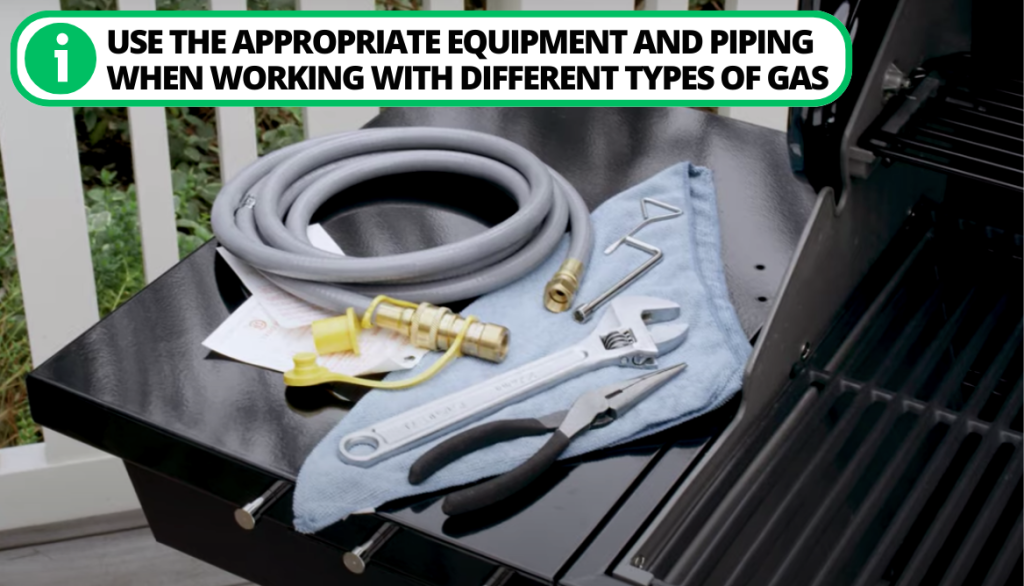
4. Inconsistent Burning
The disparity in combustion properties between propane and natural gas is also responsible for the uneven burning of the gas. Propane’s slower combustion rate demands a higher pressure and a greater amount of air to burn efficiently. When propane is utilized on a natural gas stove, an incorrect fuel ratio can result.
Benefits of Using Propane
The following is a list of advantages of using propane gas.
1. Pay Per Use
Using propane on a natural gas stove has a huge perk – you get to pay on a per-use basis. This means no more fixed monthly charges, regardless of how much you cook. This is also helpful for folks on a tight budget.
Another cool advantage is the flexibility to refuel at your convenience when prices are more favorable. So, when propane prices are down, you can stock up and use it gradually, which ends the loss of extra bucks in your pocket in the long haul.
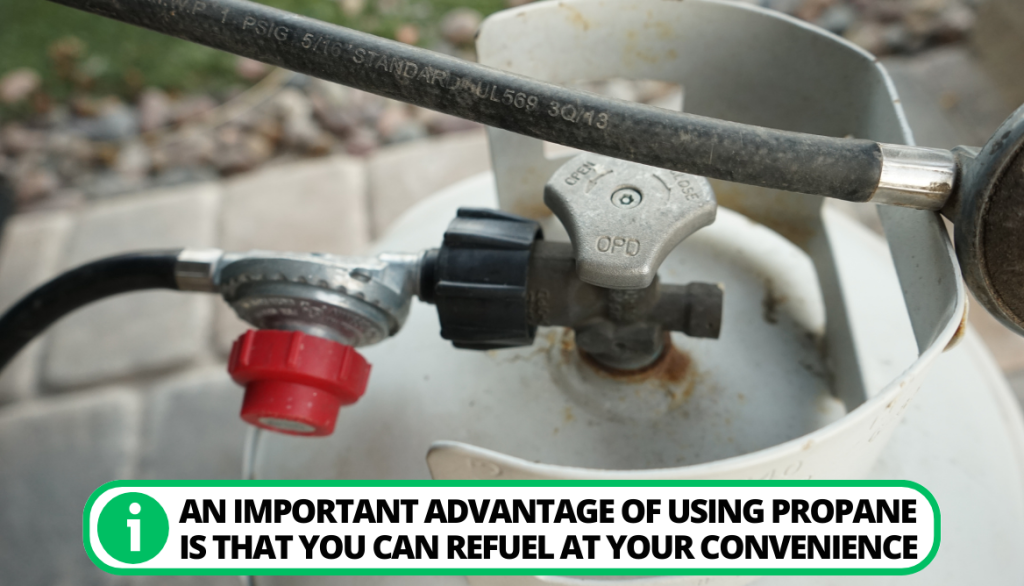
2. Environment-Friendly
Propane is more environmentally friendly than natural gas. It is a clean-burning fuel that emits fewer greenhouse gases and pollutants than natural gas. Additionally, it also has a lower risk of leaks and spills than natural gas, which can cause explosions or fires.
3. More Savings
An amazing thing about propane is that you only need half the amount of this gas compared to what natural gas costs. Imagine the savings you’ll rack up with this reduced fuel usage.
And even if propane’s price is double that of the natural gas line, don’t worry. You’ll still end up spending less overall because of the propane’s high efficiency.
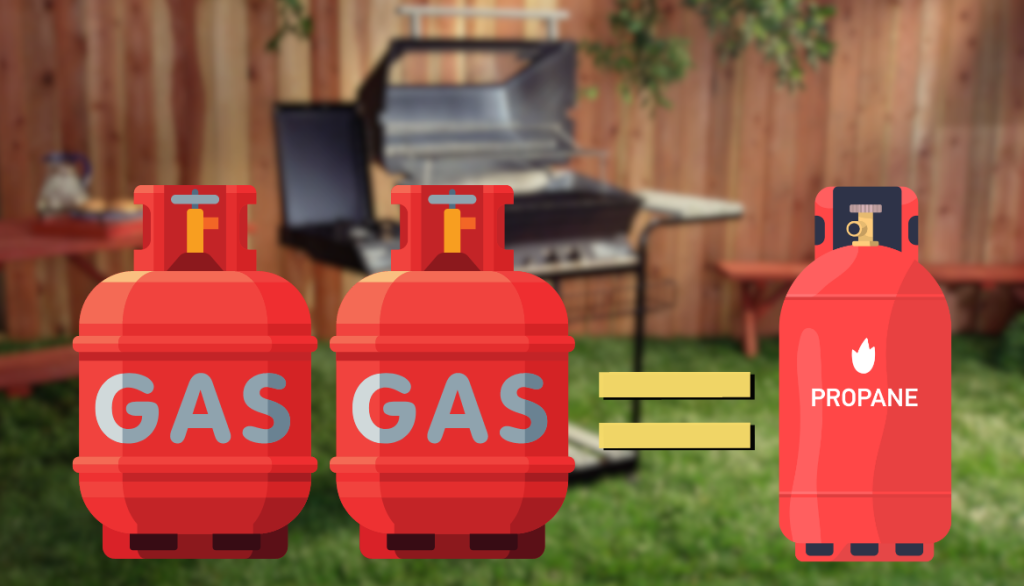
8-Step Easy Guide For Switching from Natural Gas to Propane
Let’s dive into the crucial guidelines for switching from natural gas to propane.
1. Check the Compatibility of Your Natural Gas Stove
Before you embark on converting your natural gas stove to propane, you need to figure out if your furnace is propane and carbon monoxide compatible. For this, simply check your manual, or if you can’t find it, hop online and search by the model number.
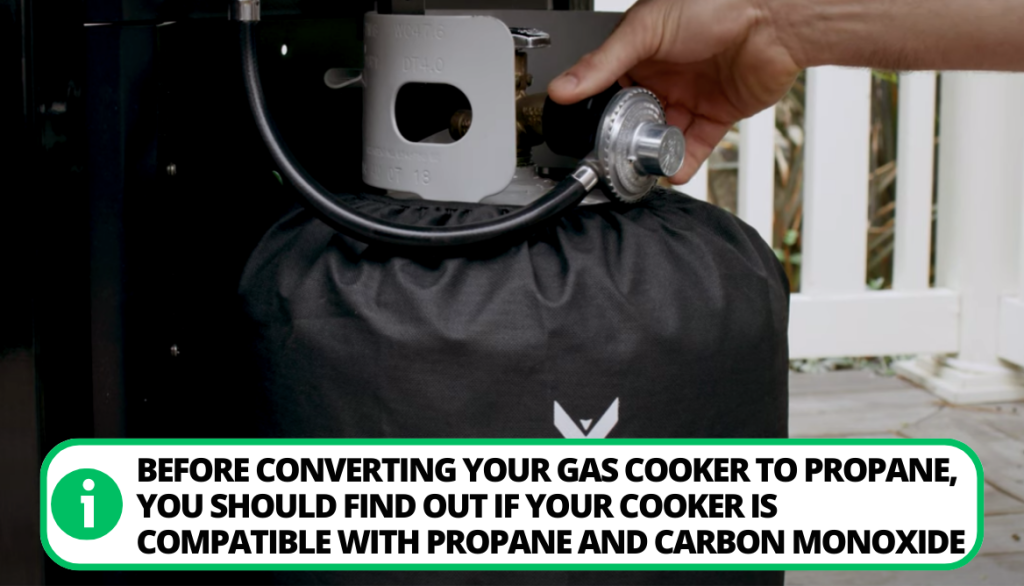
2. Get a Conversion Kit
A conversion kit is required to convert your gas stove to propane. These kits are designed to make the changing process easier and safer. These kits are readily available in local hardware stores or on Amazon.
You may also want to check with your stove manufacturer, as some burners, including LPG repairing kits, may provide information on where to purchase them.
Things To Keep In Mind Before Buying A Conversion Kit
When purchasing a conversion kit:
- You should look for one that includes all the necessary components, such as orifices, burners, and regulator settings.
- Look for the kits with instructions, as these can be helpful if you need to become more familiar with the conversion process.
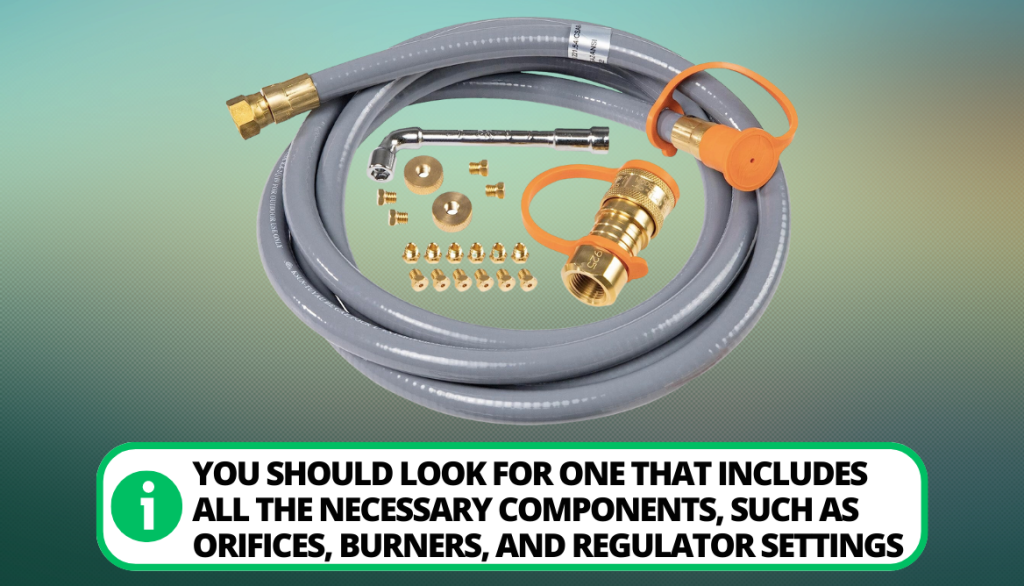
3. Disconnect the Main Supply
Before starting the conversion process, you must disconnect the main gas supply from your stove.
4. Remove the Stovetop
If you are planning to convert your natural gas stove to propane, you need to determine what type of burner you have. Not all natural gas stoves are designed the same; some might require a different process. Converting your burner begins as soon as you know its type. Follow the below-given method:
To start:
- Take the stovetop off your stove. That way, you can access the holes where the gas gets to the different burners on the furnace.
- The orifices in a natural gas stove are slightly larger than those in a propane gas oven, so you need to change them to ensure that your furnace will work properly with propane.

To find the burner outlets:
- Remove the stove’s top. Some models may need additional parts, such as the burner grates and knobs. You have to remove them first.
- Once the top is removed, you should be able to see the orifices. The heads of burners are usually found in rows, each having a gas regulator orifice plate sitting atop the valve to release air when gas is added.
Follow this process to remove the burner orifice hoods:
- First of all, grab a half-inch wrench. Then, loosen the hoods and remove the loose panels.
- Finally, remove the old orifices and replace them with the new orifices.
5. Adjust Each Burner to a Minimal Flow Setting
Before converting, you must regulate each burner to a minimum flow. To do this, follow these steps:
- First, remove the cooktop’s top lid by unscrewing it and removing the control knobs.
- Afterward, individually adjust the burners to a minimum flow by inserting a screwdriver behind the knob and turning it clockwise with one rotation or less.
- Note that the desired natural gas range can only be checked by lighting the burner when connected to the propane stoves.
- After this, place the lid and the control knobs back in place.
- Check the flow of each burner once they’re connected to the propane tank.
Why You Should Perform This Step?
Regulating each burner to a minimum flow is an important step as it ensures the proper functioning of the propane stove. Moreover, it also helps to prevent any potential safety risks.
6. Change the Regulator Settings
Changing the regulator settings is essential in converting your gas stove to propane. Failure to do so could result in gas leaks or damage to your appliance. To do this setting, follow these steps:
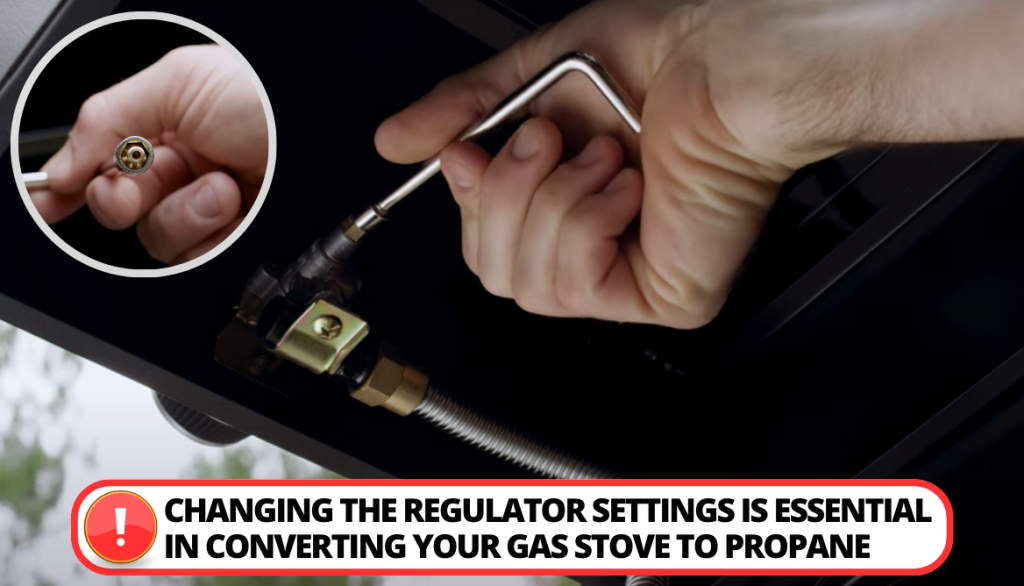
- Remove the tap cap from the regulator’s top.
- Locate the plunger inside the regulator section.
- Turn the conversion plug upside down to switch from natural gas to partially combusted propane settings.
- Screw back the tap cap tightly to avoid leaks.
7. Attaching the Propane Tank to the Natural Gas Stoves
Now that you’ve changed the regulator settings, it’s time to connect the propane tank to your stove. Here’s how to do it:
- Position the tank of propane in a safe and stable location near the stove.
- Attach the propane hose to the tank, tightening the nut securely by hand.
- Connect the other end of the hose to the propane inlet on the stove, securing the nut securely by hand.
- Inspect all connections for potential leaks by applying a soapy water solution and observing for any bubble formation. If there is a leak, shut off the propane cylinder, tighten the connection, and re-check for leaks.
- Once all connections are secure and leak-free, place the gas range cover over the stove.
- Ignite the burners and check the level of flame. The flame may be higher or lower than expected due to the difference in gas pressure and heating value between natural gas and propane.
- Adjust the flames using the burner valves to achieve the desired heat level.
8. Final Inspection
Now that you’ve successfully converted your gas stove to propane, it’s time to perform the final inspection to ensure everything works properly.
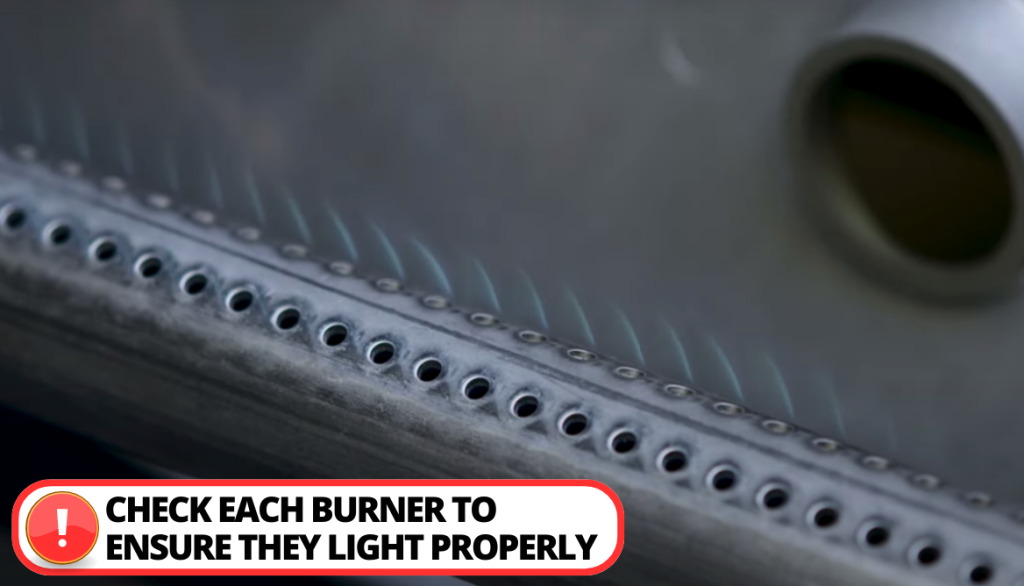
Here are the steps:
- Make sure all connections are secure and tight.
- Check each burner to ensure they light properly.
- If the flames are too high or too low, they can be adjusted by loosening or tightening the nut behind the knob. Be careful not to overtighten, as this can damage the knob.
- Check the level of flames in the oven. If uneven, the thermostat behind the central knob can be adjusted to level the flames.
- Turn on each burner and the oven to ensure they all work correctly.
3 Exclusive Safety Tips to Use Gas Stove to Propane
Converting a gas stove to propane requires careful attention to detail to avoid potential hazards. Here are some exclusive safety tips to ensure a successful conversion:
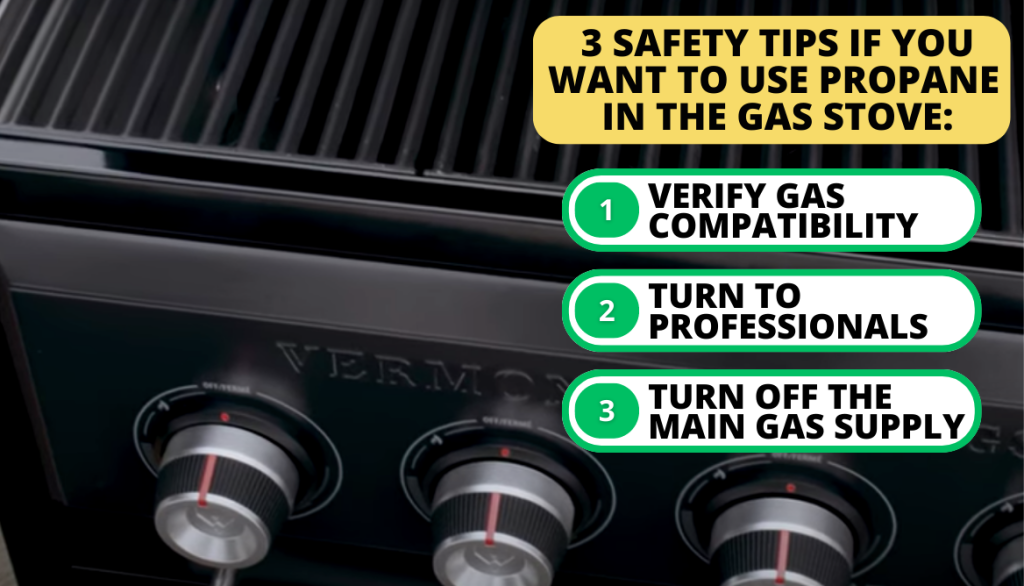
- Verify Gas Compatibility: Before you start the conversion process, ensure your gas stove is compatible with propane. It’s crucial to check the appliance’s manual or contact the manufacturer to ensure it can be converted to propane.
- Seek Professional Assistance: Converting your gas stove to propane may seem like a DIY project. However, it is advised to consult a professional with a technical background in dealing with gas appliances. They can guide you through the process, ensure safety precautions, and save you time and resources.
- Disconnect and Turn off the Main Gas Supply: Another important step while converting is to ensure the main gas supply is disconnected and turned off completely. Also, confirm that all burners are turned off, and the stove is not connected to any power source.
FAQ
Can a natural gas stove be used with propane?
Sure, with the proper precautions and a conversion kit, a natural gas stove can be used with propane. However, a professional consultation is recommended to ensure safe installation and safety.
How do you convert a natural gas stove to propane?
To convert a natural gas stove to propane, you must get a conversion kit that includes new natural gas orifices for the burners, a regulator for the propane stoves, and sometimes a new gas valve. Follow the manufacturer’s instructions carefully to ensure the safe installation of the conversion kit.
How do I know if my stove is propane or natural gas?
The easiest way to determine whether your stove uses propane or natural gas is by checking the owner’s manual or contacting the manufacturer. Another way to tell is to look for a label or tag on the stove that specifies the type of gas it uses.
Does natural gas smell like propane gas?
No, natural gas doesn’t smell like propane gas. It is usually odorless and has to be treated with chemicals to give it a distinctive smell.
Is propane safe to use indoors?
Propane is safe to use indoors as long as it is done properly and in a well-ventilated area. However, it is important to remember that propane is a combustible gas and can be dangerous if not used cautiously.
Conclusion
The final say is that you can convert a natural gas stove to one that supports propane gas as a fuel. There are many benefits to using propane properly, such as pay-per-use, environment-friendly, and cost savings.
This conversion process is indeed feasible with the right tools and knowledge. But safety measures must be followed to prevent accidents. Always check your stove’s compatibility and get a conversion kit before attempting the conversion. Lastly, consult a professional if you have any doubts or concerns.
Have you ever tried converting your gas stove to propane and how was your experience with it? Share your thoughts in the comments below.

I`m a current Law Enforcement Officer working within the Counterterrorism Bureau in New York State. I have been Camping for over 20 years. My styles of camping include tent, car, truck, van, and RV travel trailer. I have a YouTube channel where I teach all types of camping with an entertaining method: https://youtube.com/@TheSmallsRVAdventures






